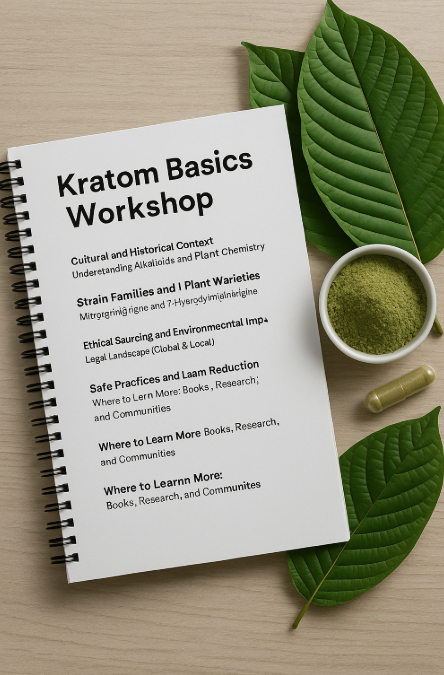As the creator economy expands, so does the appetite for thoughtful, balanced education in wellness niches that traditional institutions often overlook. One such subject, kratom, has generated increasing curiosity among those interested in alternative wellness, ethnobotany, and plant-based self-care. While regulatory and ethical boundaries must always be respected, there's still a growing space for non-commercial, educational courses that help people understand kratom’s cultural context, its potential uses, and how to approach it safely and critically.
If you're a creator looking to design a “Kratom 101” workshop or foundational guide, this article will help you map out the key elements of a responsible and informative course, without crossing into medical or promotional territory.
Why Create a Kratom Basics Course?
The demand for plant-based wellness education is rising. People are seeking clear, trustworthy information about natural substances, especially those with complex reputations like kratom. However, much of the content online is either overly technical or veers into unregulated sales pitches.
By creating a balanced educational course, you help fill this gap, offering a resource that informs, empowers, and encourages critical thinking. And by focusing on historical, cultural, scientific, and wellness perspectives, you stay aligned with legal and ethical standards while providing genuine value.
Key Elements to Include in a Kratom Basics Workshop
1. Cultural and Historical Context
Start by grounding the learner in where kratom comes from, the Mitragyna speciosa tree, native to Southeast Asia. Explore how kratom leaves have been traditionally used in countries like Thailand and Indonesia, often by manual laborers or in ceremonial contexts.
This section frames kratom as a botanical subject, not a recreational substance, and helps demystify its background.
2. Understanding Alkaloids and Plant Chemistry
Introduce kratom’s primary active compounds, such as mitragynine and 7-hydroxymitragynine, and how they interact with receptors in the body. Emphasize that kratom is complex, not a one-size-fits-all plant, and that effects can vary based on dosage, strain, and individual biology.
You don’t need a science degree to write this section; just stick to simplified explanations and cite credible academic sources.
3. Strain Families and Plant Varieties
This is often the most confusing area for beginners. Break down the main color types (green, red, white) and what users often report in terms of experience. While anecdotal, this section can help students understand how individual variation and expectations play a role.
Avoid making medical claims. Instead, position this section as a taxonomy of plant varieties and their traditionally associated characteristics.
4. Ethical Sourcing and Environmental Impact
In a world increasingly focused on sustainable practices, it’s vital to include a discussion about how kratom is grown and sourced. Is it wild-harvested? How are local communities treated? What does ethical production look like?
This elevates your course from basic education to conscious consumerism, something many learners deeply value.
5. Legal Landscape (Global & Local)
Laws around kratom vary widely by region. Some countries allow it freely; others ban it outright. In this section, include a neutral, up-to-date overview of the legal status in key regions like the US, UK, EU, and Southeast Asia. Use reliable legal sources, and include a disclaimer that laws are subject to change. For example, it’s legal to buy kratom in the US.
This helps learners stay informed, and signals that your course is education-first, not product-driven.
6. Safe Practices and Harm Reduction
Rather than promoting kratom, frame your course through the lens of informed decision-making and risk reduction. This might include:
- Recognizing adverse effects
- Understanding potential for dependence
- The importance of moderation and breaks
- Avoiding combinations with certain medications or substances
This portion is critical for maintaining trust and integrity. The goal isn’t to endorse kratom, it’s to help people think more carefully if they’re already engaging with it.
7. Where to Learn More: Books, Research, and Communities
End your course by guiding learners to additional resources, academic research, books, nonprofit organizations, and online forums. This not only helps extend their learning journey but also reinforces that your course is part of a broader, evolving conversation.
Avoid linking to product sellers. Instead, focus on neutral educational sources and community-driven platforms.
Course Format Suggestions
- PDF Guide or Ebook: Great for learners who prefer to read and reflect offline.
- Video Modules: Offer voiceover slides or face-to-camera segments to walk students through each topic.
- Accompanying Workbook: Include prompts, reflection questions, or a “Kratom Knowledge Journal” to help learners apply what they’ve learned.
- Quizzes or Self-Assessments: To help reinforce understanding in a non-graded, learner-friendly format.
Final Thought: Empower Without Preaching
Creating a digital course about kratom is not about taking a stance, it’s about curating accurate, nuanced, and respectful information for an audience that’s eager to learn.
With platforms like Payhip, you have the freedom to deliver niche educational content directly to your audience. If approached with care, a Kratom Basics Workshop can be a meaningful, ethical, and impactful addition to the broader wellness education space, no hype or sales needed.

